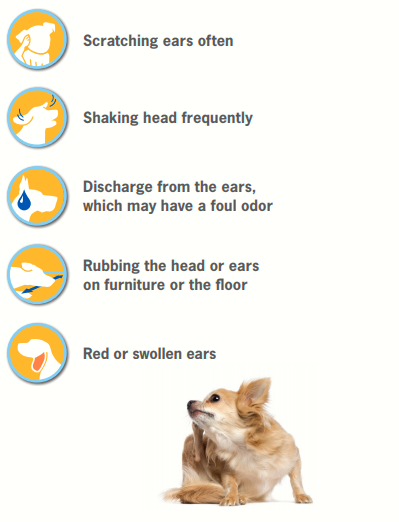
Ear Infection
One of the most common reasons for veterinary visits is Otitis Externa, or ear infection.1 Otitis externa may be caused by a number of factors and can be acute or chronic in nature. If your pet suffers from allergies, swims or is bathed frequently, has underlying immune disease, has suffered from ear mites, has food sensitivities or has been diagnosed with endocrine disease such as hypothyroidism, it may develop otitis externa at some point in it’s life. This common condition affects both dogs and cats across America and can be a pain for them and you.
Otitis externa occurs when the outer ear becomes red and swollen or inflamed. When this occurs, bacteria and yeast normally found in low numbers in the ear canal will grow abundantly causing infection. Fungal ear infections are rare.
Symptoms of otitis externa in your pet may be pawing or scratching at the ear, tenderness around ear when petted, abnormal smell or discharge from the affected ear(s).2
Speak with your veterinarian if you notice any of the following signs in your dog:

Examination of the external ear and the canal are necessary if otitis externa is suspected. An otoscopic exam allows for a more thorough evaluation of changes to the pet’s ear canal, characterization of any debris present, and visualization of the tympanic membrane or ear drum. Palpation of the ear canal also helps to determine if it feels normal, firm or calcified to help guide further diagnostic and treatment considerations. Ear cytology is critical in every otitis externa case. This diagnostic tool guides the choice of treatment, determines response to therapy and aides in determining the need for a culture of the ear canal. An ear culture is necessary when the otitis externa is severe or if infection has spread deeper in the canal causing otitis media.
Therapy for otitis externa involves diagnosing and treating any underlying disease that may be contributing to the ear infection and elimination of the ear infection.3 Prevention of future ear infections requires practicing good ear hygiene such as gentle routinely cleaning and being vigilant for symptoms of ear infection in your pet.
References: 1. Top 10 reasons pets visit vets. Veterinary Pet Insurance website. Available at: https://www.petinsurance.com/healthzone/pet-articles/pet-health/ Top-10-Reasons-Pets-Visit-Vets.aspx. Accessed August 3, 2015. 2. Moriello KA. Overview of otitis externa. In: Aiello SE, Moses MA, eds. The Merck Veterinary Manual online. http://www.merckvetmanual.com/mvm/eye_and_ear/otitis_externa/overview_ of_otitis_externa.html. Accessed November 1, 2015. 3. Radlinsky MG, Mason DE. Diseases of the ear. In: Ettinger SJ, Feldman EC, eds. Textbook of Veterinary Internal Medicine. 7th ed. St. Louis, MO: Saunders Elsevier; 2010:1011–1030.
